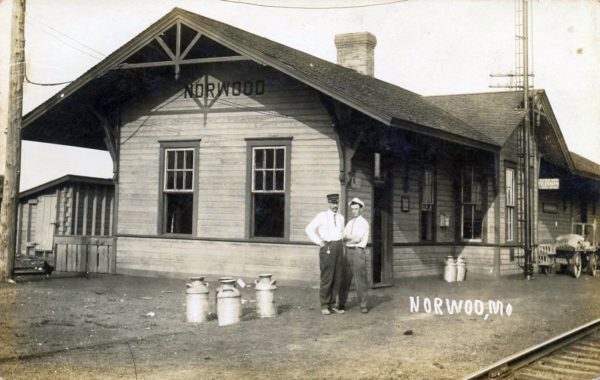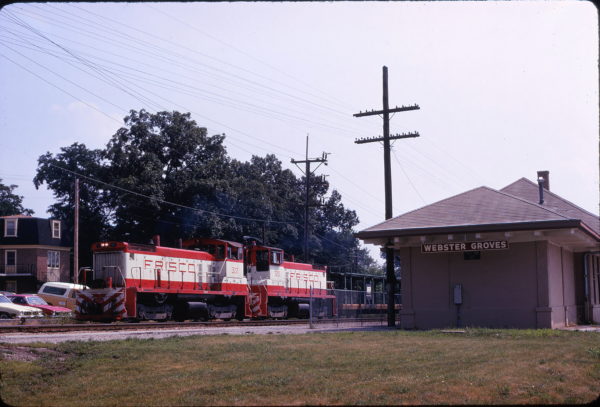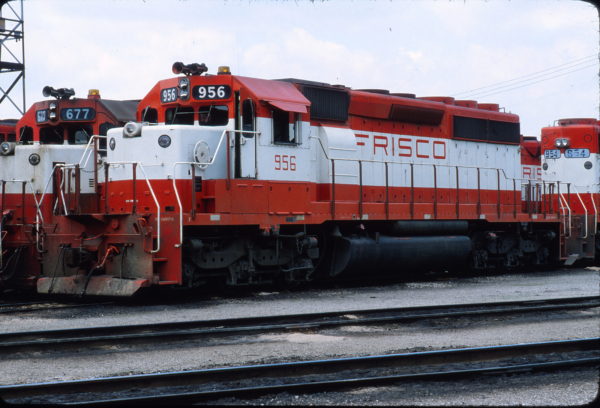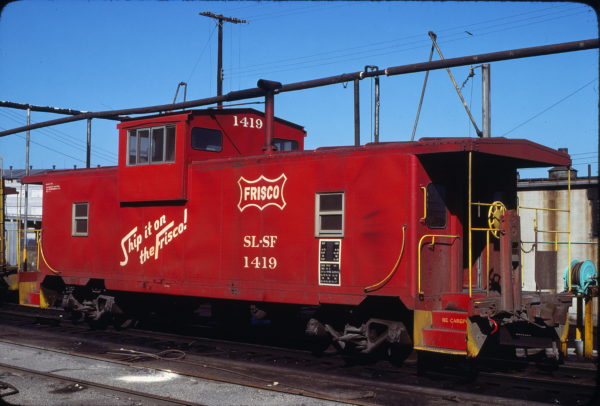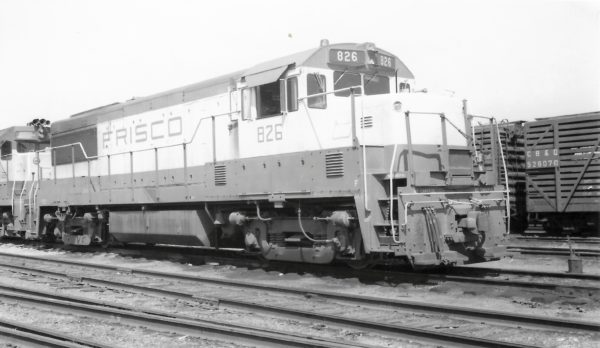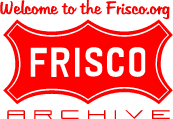Monthly Archives: November 2017
SW1500s 322 and 320
4-8-2 4302
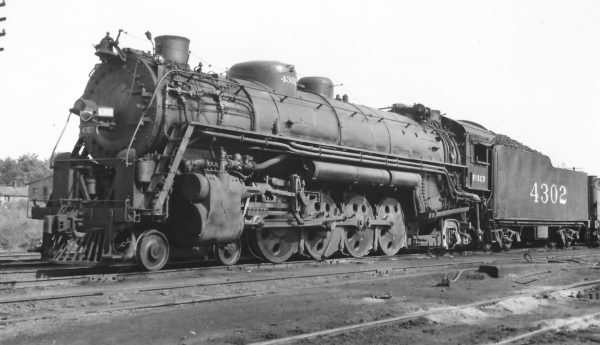
Frisco-built 4-8-2 4302 at Fort Scott, Kansas on July 11, 1947 (Arthur B. Johnson).
The locomotive facilities at Fort Scott during the steam era serviced coal fired engines. Included was a wood timber, and later concrete, coal tower for fuel. In this view coal is piled high in the locomotive’s tender.
As the fuel is burned on the firebox grate it creates considerable amounts of waste that falls and collects in the locomotive’s ash pan. Most of the air for proper combustion comes up through the firebox grate. Therefore, the ash pan must be cleaned regularly for the fire to burn properly.
Note in the lower left corner of the photograph the tie stub ends at the ash pit. As locomotives go through their turnaround servicing cycle they typically visit the ash pit track. The tools and hose in the foreground are for cleaning out an engine’s firebox ash pan.
The hook shaped metal tools are used to rake, shake and dump out the external combustion engine firebox grate and ash pan. Ash and cinders are dumped into the pit between the rails. Noncombustible pits were common to prevent the hot material, if dumped directly on the ground, from starting tie fires.
Water from the hose was sprayed to cool the firebox waste. Once cooled the waste material was loaded for disposal by conveyor, hoist, lift or shovel. Open top gondola and hopper rail cars were common in this service. Recycled material was distributed for railroad sub roadbed, roadway construction, concrete manufacturing and other uses.
Special thanks to Mark Davidson.
SD40-2 956
Railway Post Office 211
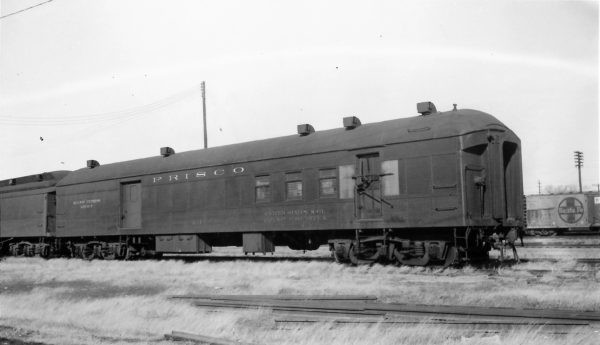
Railway Post Office 211 at Springfield, Missouri on January 26, 1964 (Arthur B. Johnson).
U25Bs 805 and 814
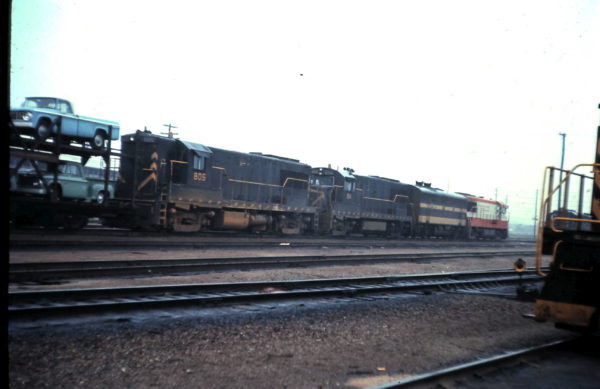
U25Bs 805 and 814 at Springfield, Missouri (date unknown).
The train is westbound entering the east end of Springfield Yard. This yard was also known as West Yard or Kansas Avenue Yard. Behind U25B 805, through the bi-level automobile carrier or autorack, one can see the northwest corner of the Springfield Stockyards. The head end locomotive is south of the service tracks area.
The oily track in the foreground is the lead to the east end of the service tracks area and further west the diesel shop. The photograph was taken from the diesel pocket-track. This locomotive longer term storage track is east of the Springfield Diesel Shop. Directly behind the photographer is the east end lead to the West Shops area, Benwood Yard and Clinton Subdivision.
Note the Alco locomotive parked on the diesel pocket track. The distinctive lower railing with hooped end just above the pilot was a common feature on their early locomotives, including Frisco owned models S-2, RS-1 and RS-2. In the distance, through its handrails, can be seen additional locomotives at the service tracks area.
The photograph was taken between early 1965 and late 1967. The earlier date is established by the presence of a locomotive in mandarin orange and white paint. This paint scheme first appeared on U25Bs 802 (repainted on February 14, 1965), and 816 (delivered new on March 12, 1965). The later date is established by the second generation Dodge D Series grills on the pickup trucks (model years 1965-1967). The grills were modified to a different design with the 1968 model year.
The view is looking southwest.
Special thanks to Mark Davidson.
Cattle Car 47864
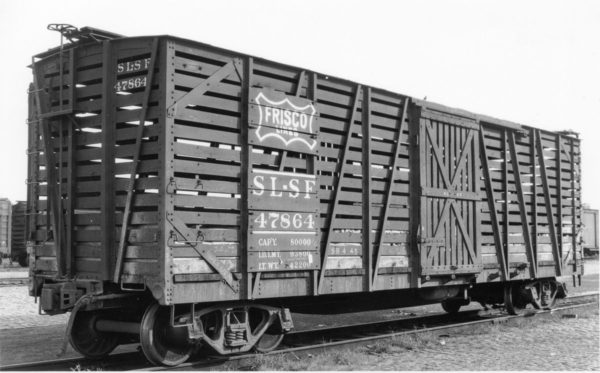
Cattle car 47864 (date and location unknown).
Built during 1923, this is one of 300 similar 40 foot 5 inch inside length cars in the series 47700-47999.
This livestock, or stock car for short, was constructed by the Mount Vernon Car Company. The car builder was a frequent advertiser in the company’s Frisco Employees’ Magazine. A photograph of one of these cars was a prominent feature in their advertisements.
This group of cars as originally built was assigned Association of American Railroads (AAR) classification “SM”. The “S” class denotes cars for the transportation of livestock on the hoof. The “M” denotes cars with slated sides and side doors, with a single deck. Starting around 1940, at least 49 cars were modified into double deck cars for hauling smaller animals including pigs and sheep. As a result, these were reassigned into the AAR classification “SF”. This denotes stock cars equipped with a fixed double deck.
The cars were built around a fishbelly shaped longitudinal center sill underframe. Cross bears supported inward facing C-shaped side sills. To this backbone was attached a steel framework of Z-shaped angle irons. Open slat wood sides and ends were then attached to this steel framework. On top they incorporated relatively rare Samson brand radial roofs.
As seen in this view, the cars featured a vertical staff hand brake. On top of the staff rod the brake wheel attached in a horizontal position. This arrangement was retained throughout their service lives. The cars were originally built with KC-style air brake systems. These were modernized and replaced with newer AB-style air brake valve systems starting in the 1940s.
Large surface letter boards were provided for the corporate herald, car reporting marks, numbers and weight data. From the end these were attached to the second bay framework, to the left of the door. Other dimensional information and data was applied directly to the individual wood slats.
The cars, including the underframe, were painted freight car red. Reporting marks, car numbers, lettering and coonskin heralds were painted white. Car loading doors were painted yellow. Over the years a number of cars had repaired or replacement doors painted the carbody color. In this photograph routing chalk marks can be seen on the car sides.
Photos show the heralds with and without a black background. The heralds also underwent transitions. As delivered the herald had the stacked lettering FRISCO LINES. After the corporate herald change in 1947, the company dropped the word LINES. From that point heralds were seen with LINES simply painted out, leaving FRISCO offset to the top or if repainted featured the new herald with centered FRISCO.
Typical service was moving animals between grazing lands, feed lots and slaughter houses. In addition to hauling livestock the cars also were used for other commodities. Shipments included watermelons, coke used in steel making, hay and similar feed stock.
This photograph was taken in the mid to late 1940s. This is established by the last reweigh date, April 1945, but before the FRISCO LINES herald was modified.
Special thanks to Mark Davidson.
Caboose 1419
U25B 826
GP7s 574, 603, 539 and VO-1000 232
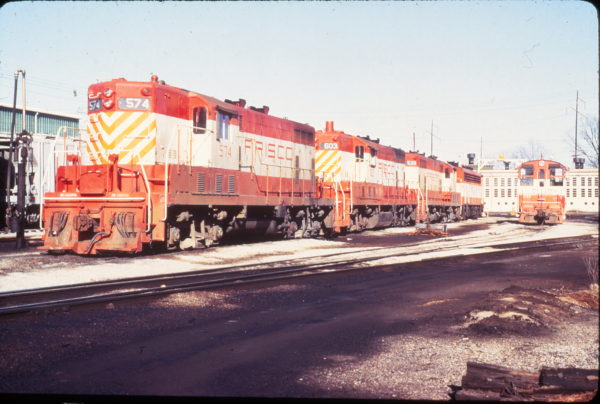
GP7s 574, 603, 539 and VO-1000 232 at Fort Smith, Arkansas on February 13, 1972.
